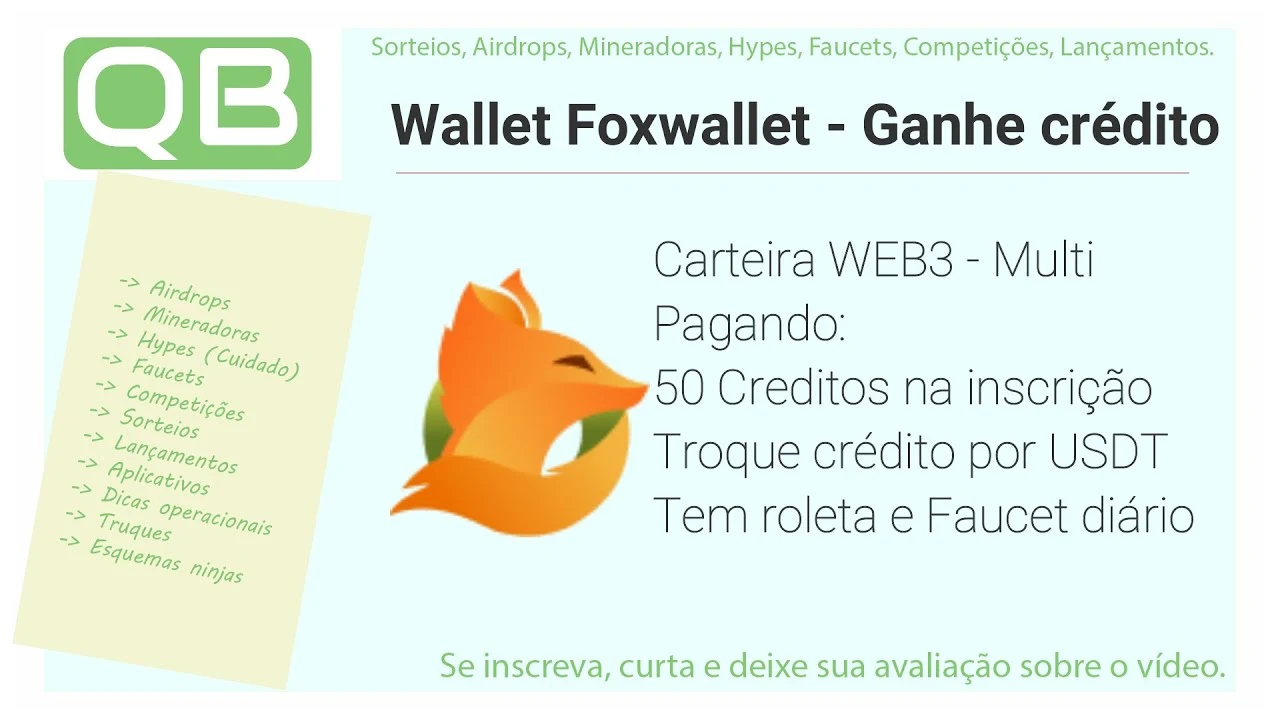
Como ganhar crédito e trocar por USDT na Foxwallet com faucet e airdrop
Saque grátis e fácil 🆓💰🔥
Reivindique crédito diário na carteira Foxwallet por 7 dias consecutivos e maximize seus ganhos 🤑
Ganhe até $20 dólares diários em USDT — moeda digital estável e valorizada 💵
Para apoiar o canal, utilize o código de convite: pY2kaa3oa7
Além disso, participe do airdrop oficial da Galxe utilizando a Foxwallet para aumentar suas chances de ganhos:
Quiz para testar seus conhecimentos sobre Caldera e blockchain
Responda as perguntas abaixo para entender melhor a tecnologia por trás do airdrop:
- Qual framework de escalabilidade Caldera utiliza?
Resposta: A. Optimistic Rollups - O que é um “batch” no contexto de rollups?
Resposta: B. Grupo de transações processadas juntas para melhorar escalabilidade. - Como os rollups L2 diferem das cadeias L1?
Resposta: D. Processam transações fora da cadeia principal para reduzir congestionamento. - Diferença entre Optimistic e Zero-Knowledge Rollups?
Resposta: B. Optimistic usa provas de fraude; Zero-Knowledge usa provas criptográficas complexas. - Verdadeiro ou falso: taxas aumentam conforme mais usuários entram em blockchains monolíticas.
Resposta: C. Verdadeiro - Como Caldera melhora o modelo monolítico?
Resposta: D. Todas as opções acima - Qual serviço principal Caldera oferece?
Resposta: A. APIs, SDKs e ferramentas para facilitar o desenvolvimento. - Onde Caldera oferece personalizações?
Resposta: G. Todas as opções mencionadas - Recursos adicionais oferecidos pelas cadeias Caldera?
Resposta: E. Todas as opções acima - O que é uma camada de liquidação?
Resposta: B. Camada base onde transações são finalizadas com segurança. - O que é camada de disponibilidade de dados (DA)?
Resposta: C. Camada que garante dados do bloco disponíveis para participantes.
Questões avançadas para quem quer se aprofundar em Caldera
- Vantagem da compatibilidade EVM de Caldera?
Resposta: C. Combina múltiplas vantagens de compatibilidade e ferramentas. - Quais ferramentas são compatíveis com Caldera?
Resposta: D. Todas as mencionadas - Stacks de rollup compatíveis atualmente?
Resposta: B. OP Stack e Arbitrum Orbit - Caldera oferece precompiles customizados?
Resposta: A. Sim, oferece - Tipos de aplicativos que podem ser construídos?
Resposta: D. Todos os tipos listados - Objetivo da ponte embutida em Caldera?
Resposta: B. Facilitar movimentação de ativos entre Caldera e blockchain principal - O que é um Oracle?
Resposta: A. Fonte externa de dados para blockchains e smart contracts - Token para pagamento de taxas de gás?
Resposta: B. Token nativo da cadeia (exemplo: Ether na Ethereum) - Tokens aceitos para pagamento de taxas na Caldera?
Resposta: A. Qualquer token ERC-20 escolhido pelo desenvolvedor - Maior vantagem dos tokens personalizados para taxas?
Resposta: C. Simplifica a experiência do usuário eliminando múltiplas moedas - Quer construir um app na Caldera?
Resposta: A. Sim!
Aviso importante: Sempre faça sua própria análise antes de investir em criptomoedas. Os ganhos dependem de múltiplos fatores e o risco está presente.